SHORT ABSTRACT:
- Nearly 13% of the world population is suffering from obesity (2014 estimation).
- The human body is complex. There are many models that represent body weight or whole-body composition.
- Obesity and environmental pollutants. Evidence points to endocrine-disrupting chemicals that interfere with the body’s adipose tissue biology, endocrine hormone systems, or central hypothalamic–pituitary–adrenal axis as suspects in derailing the homeostatic mechanisms important to weight control.
- Nutrition: Words that actually mean “added sugar”.
- Change starts with you! Stop doubting yourself and get to work to change what you can.
Most of the world is fat! Don’t give me the political correctness crap, numbers don’t lie. Is that a fact? (You ask sarcastically). Well, I’m glad you asked, my dear fellow traveler! Let me show you a before-and-after picture of age-standardized mean BMI in women by country. The before the shot is from 1975 and the after is from 2014. The 2014 shot seems like an aftershock of a nuclear fast-food sandwich that blew up and left (almost) everyone fat.
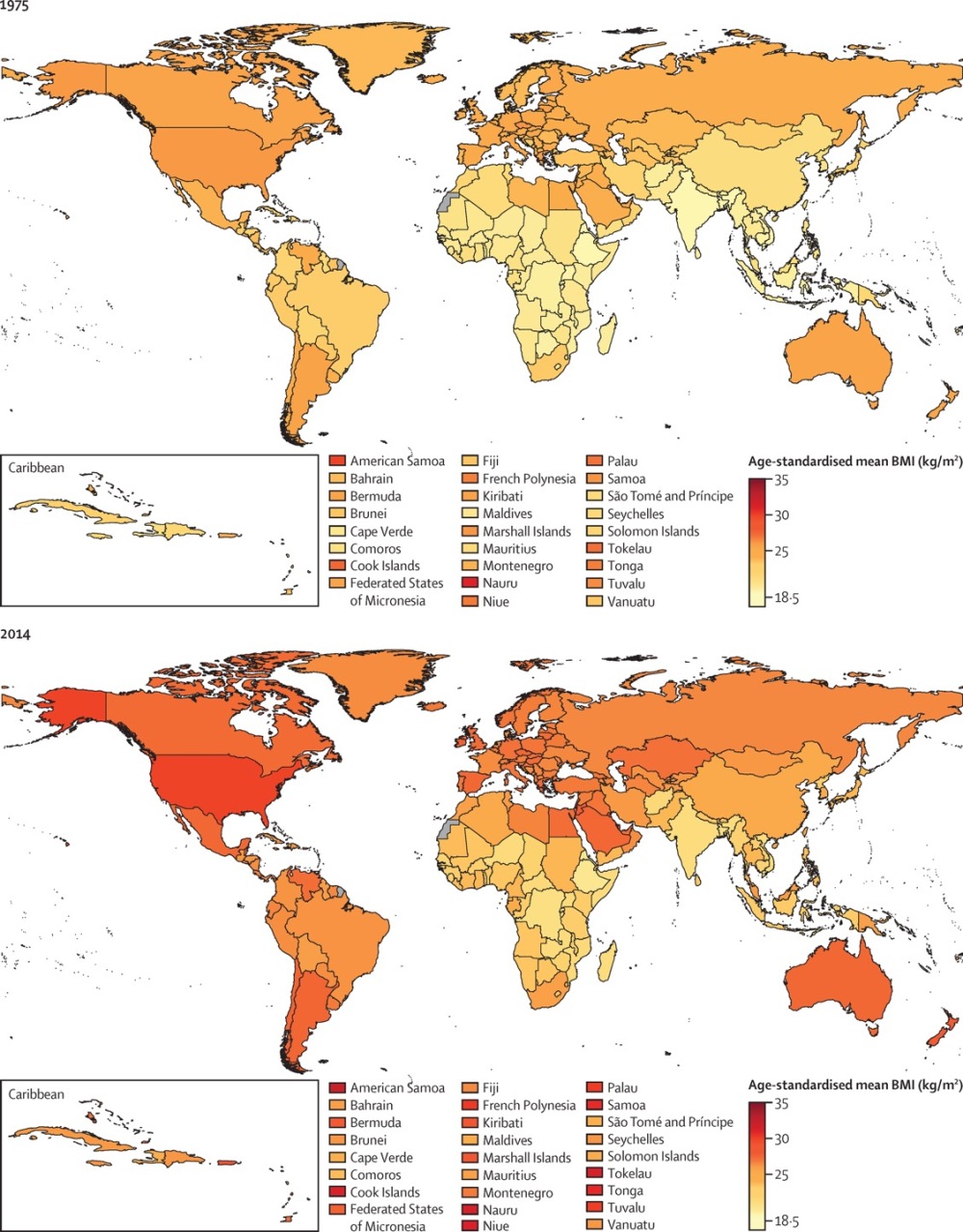
The journal that published this eye-opener is the British medical journal The Lancet. Look at the 2014 picture – it’s becoming a pandemic, not an epidemic! Nearly 13% of the world’s population is now suffering from obesity. The study also gives us the number of people with obesity worldwide before and after – 105 million and 641 million, respectively. Here’s another number for you: global obesity in the years between 1975 and 2014 has increased by 167%.
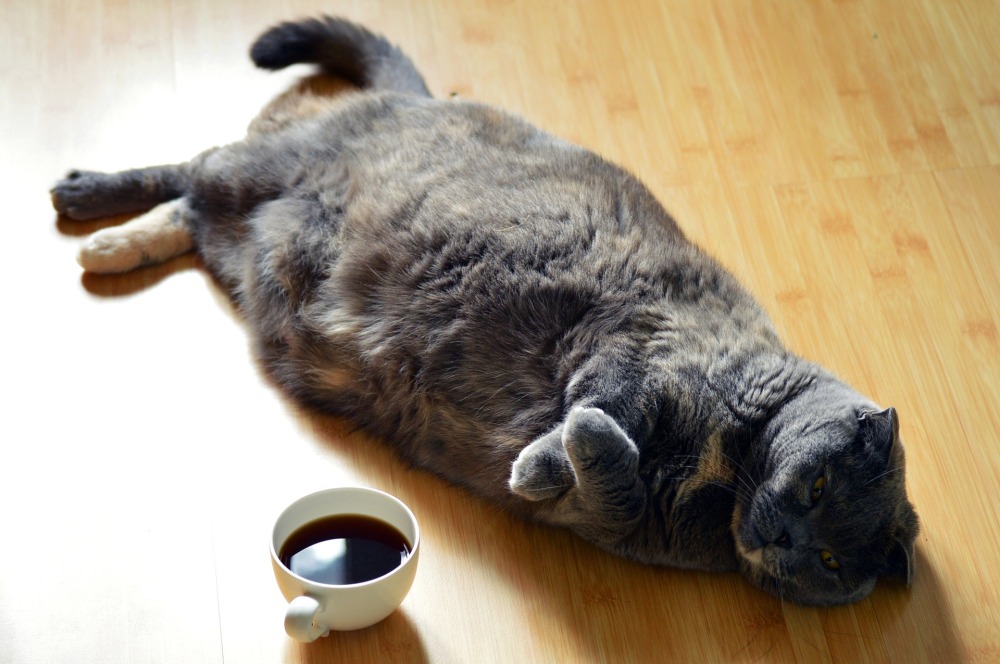
Should I go on?
I know people who are suffering from obesity. We’ve talked a lot about the weight it carries (no pun intended). It doesn’t just bring physiological health problems. It brings emotional and psychological ones, too. It brings isolation, loneliness, and depression. It also brings discrimination, pity, bitterness, and anger. People with obesity are overlooked by doctors, mostly because doctors don’t know how to treat obesity. It’s a story with its own merit. People with obesity are overlooked by headhunters and employers. I wouldn’t even touch this one. We all know it happens all the time.
What I would touch, on is the theme of environmental pollutants and obesity. And nutrition and stuff.
The human body is an amazing creation.

On an atomic level, the body weight is represented by a lifetime accumulation of only six main elements, those are: oxygen, carbon, hydrogen, nitrogen, calcium, and phosphorus. Sulfur, potassium, sodium, chlorine, magnesium, and nearly 40 other elements cover less than 2% of body weight.
On a molecular level, we see elements distributed into molecular components which can be grouped into 5 main categories: lipids, proteins, glycogen, water, and minerals. The molecular level is often divided (for practical purposes) into 2 main components: fat and fat-free mass (FFM). The fat-free mass is usually considered to be metabolically active at the molecular body composition level. There are molecular-level models that are based on 3 components: fat, lean soft tissue, and bone minerals. In literature, we can also find more complicated three-, four-, and even six-component molecular level models, which apply body volume measurements as a core, and other additional measurements for quantifying more components.
On a cellular level, we see the molecular body composition components form the basis of functioning cells, and the cellular level of body composition is usually described by three components: cells, extracellular fluid, and extracellular solids. Cell mass is further divided into fat and a metabolically active portion called body cell mass. So, the resulting components are: fat, body cell mass, extracellular fluid, and extracellular solids.
On a tissue-organ level, we see cellular components forming tissues and organs of the body, such as: adipose tissue, skeletal tissue, bone, skin, heart, and other visceral organs. A combination of these tissues and organs gives us the end result – a whole human body. Add a little silicon and you get a (certain) movie star.
This “division” of the human body is one of the models that represent the body weight or whole body composition. It shows how complex we really are. Body weight is a reflection of total body energy content and long term weight-change is a measure of energy balance. (1)
The root cause of obesity is thought to be a prolonged positive energy balance. At the physiological level, obesity can be defined as a condition of abnormal or excessive fat accumulation in adipose tissue to the extent that health may be impaired. (2)
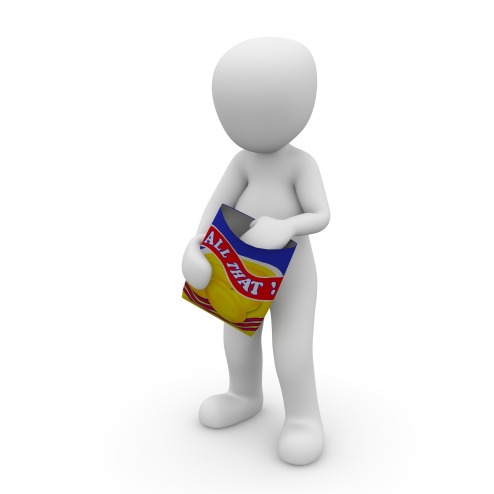
The regulation of food intake is complex, as is the evolution toward overeating and obesity. Many factors are in-game: hormones (orexigenic neuropeptides, leptin, glucocorticoids, insulin, galanin, etc), factors that modulate food intake, genetic predisposition, psychology, stress, habits, nutrient quality, exposure to environmental chemicals and endocrine disruptors. So, in short – genetic, behavioral, and environmental factors.
Evidence points to endocrine-disrupting chemicals that interfere with the body’s adipose tissue biology, endocrine hormone systems, or central hypothalamic–pituitary–adrenal axis as suspects in derailing the homeostatic mechanisms important to weight control. (3)
There is no easy “fix” to protect or intervene against diseases and syndromes associated with exposure to environmental pollutants. Poor dietary habits (high intake of processed food rich in fat and low intake of fruits and vegetables), as well as a sedentary lifestyle clearly contribute to today’s compromised quality of life in many countries. It is becoming increasingly clear that nutrition can regulate the toxicity of environmental pollutants. Certain diets can contribute to compromised health by being a source of exposure to environmental pollutants. Many of these chemicals are fat soluble, and thus fatty foods contain higher levels of persistent organics than vegetable matter. Nutrition can dictate the lipid medium, oxidative stress, and antioxidant status within cells. The regulation of these parameters by the person’s choice of nutrition may have profound effects on biological processes, and in turn, influence the effects of environmental pollutants to cause disease or dysfunction. (4)
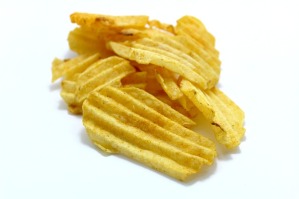 vs.
vs. 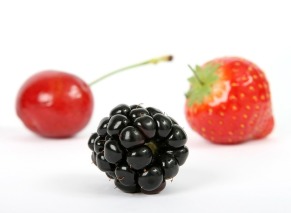
So, what kind of diet should we choose, to avoid being exposed to such pollutants? Well, basically, whatever you choose to eat probably is exposed to (even very small amounts) of POPs and other chemicals. Here’s a scary picture for you:
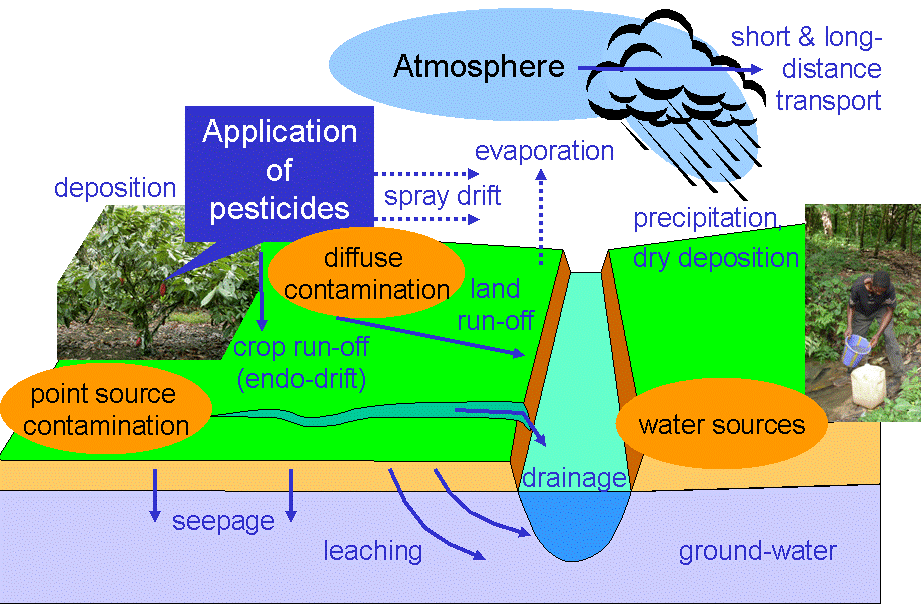
Image Source: Roy Bateman at English Wikipedia [CC BY-SA 3.0], via Wikimedia Commons
Toxic chemicals may get into the food causing food pollution in a variety of situations including:
- growing of food (e.g., crops, fruits, vegetables) in polluted soils, solid wastes (e.g., mine tailings) or areas with polluted groundwater;
- irrigation of grown food (e.g., vegetables, fruits, crops) with polluted water;
- growing of food (e.g., crops, fruits, vegetables) in areas with polluted air;
- agricultural treatments with pesticides, insecticides, and/or herbicides;
- agricultural application of sewage sludge and/or polluted fertilizers (which contain ash from power plants);
- consumption of polluted water and/or food by animals (fish or other animals);
- food processing, packaging, and handling;
- propagation and concentration of pollutants through the food chain.
The fact that plants (vegetables, crops, or trees) become contaminated with pollutants from the environment is based on the ability of plants to extract environmental pollutants along with water and nutrients through their roots. (5)
There is no way to live a life unaccompanied by chemicals. It’s the 21st century and we are dependent on many industries. Those industries use many different chemicals, many of which are not good for us or the environment. So, a few questions remain to be answered:
1. What should we eat? This one’s easy – eat whatever you want, as long as it’s not processed. More importantly – eat in moderation. I say this, because fruits, for example, contain a lot of sugar, and if you don’t control your portions, fruits will do more damage than good. Eat eco fruits and veggies and organic meat (if you eat meat). We’ll discuss the terms “eco”, “organic”, “natural” and “bio” in another post. Stay away from added sugar! Sugar has many names and it’s difficult to recognize it, but not impossible. Here’s something that might help you:
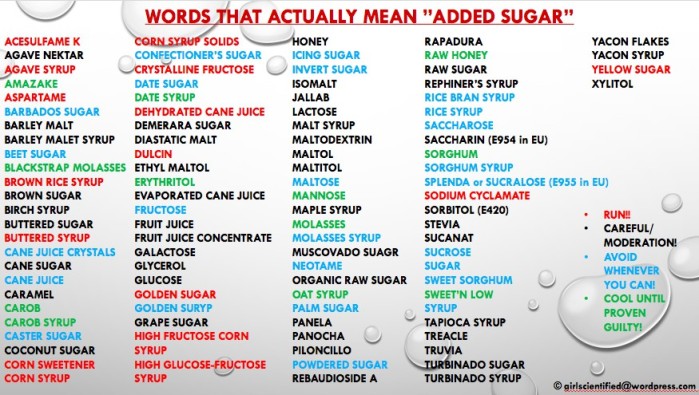
To explain the above picture: everything in red is bad (causes diseases, could be cancerogenic, is processed, etc), and the “sugars” marked with black color should be used in moderation, either because they contain fructose (excessive use is bad for the liver), or if used excessively can act as a laxative, or are still under “surveillance” by the authorities. The blue ones are either “pure” white sugar, or it means that I’ve found some alarming results from different studies about their safety. The green ones are OK until new studies show that they are not. Something like that can happen because the scientific studies of nutrition and health often change, either because technology advances and new, better studies can be done, or old studies are flawed and new ones give us totally different results. Journalistic interpretations are also in the game, as many journalists only read the summaries/abstracts from the studies and don’t bother to read the whole thing. The result is public misinformation and fear. There are studies sponsored by companies, that frame the results as good and helpful. There are also good studies that unfortunately can’t be duplicated and are therefore dismissed. Sometimes study samples are too small, and so on. This is why I say – eat whatever you want, as long as it’s not processed, and eat it in moderate portions.
2. What should we drink?
- Water–filtered. You can buy a water filter anywhere.
- Tea (if you like it sweet, add raw honey (wait ‘’til the temperature of the tea drops (50-60°C or 122-140 F), otherwise you’ll destroy many nutrients and also lower the bactericidal action of the honey). (6) If you can’t eat honey or any sugars, add sweetener (stevia, saccharin – avoid if you’re pregnant or breastfeeding, erythritol, xylitol).
- Fruit juice? Be careful with this one. Check the container and see if it says “nectar” or “100% juice”. If it’s the first one, kindly put it back on the shelf. It means added sugar. If it’s the second one – again, be careful, as fruit (whether it’s the fruit itself or its juice) contains a lot of natural sugar (fructose). So, fruit juice – sure, but sparingly.
- Yogurt – Stay away from fruit yogurts. They contain more sugar than a can of soda. Opt for a regular one, and if you like the taste of fruit, chop some fruits by yourself and add them to your yogurt. Yummy!
- Milk – Sure, but if you’re lactose intolerant look for lactose-free milk. (Same for yogurt. Side note: Greek yogurt has very, very little lactose.)
- Coffee – if I say no to this one, would you even listen to me? No? Good, because I wouldn’t listen to me, either. ‘Nuff said.
- Aloe drinks… If you’re on any kind of medication, avoid it. It can decrease the absorption of intestinally absorbed drugs. If you drink it excessively, it will act as a laxative, meaning, you’ll get diarrhea. So, be careful. (7)
- Coconut water – It has more potassium than four bananas and it’s super hydrating. It will not laundry a list of diseases, though. It’s great in smoothies, and if it’s too expensive for you, remember – good old plain water is always there for you.
- Sports drinks or isotonic drinks – they are made to replace the sugars that you lose after a long workout. If you don’t exercise, they are not useful to you.
- Alcohol? If I say no, would you listen to me? No? The newest guideline says men and women should drink no more than 14 units of alcohol per week, these units should be spread out throughout the week and they should have at least two alcohol-free days a week.
3. What to do? – Exercise and don’t worry! A sedentary lifestyle and stress are worse than sugar. Join a gym. It can be nerve-wracking at first because you think people are judging you and staring at you, but I can assure you, in the gym – nobody cares. People would glance at you and think – hmm, I don’t know him/her. And that’s it! If you don’t like the gym, there are a million things you can do – from Yoga and Pilates to cycling, hiking, and running.
4. Who to talk to? – Talk about it! Especially stress-eaters. DO NOT hold it in. There are support groups and doctors almost on every corner. Obesity clinics and medical weight loss centers provide a safe, solid option for adults looking to get serious about shedding pounds. And, since children these days can also develop diseases that are associated with obesity, such as type-2-diabetes, high blood pressure, or fatty liver, there are also obesity outpatient clinics for children and adolescents.
Obesity feeds too many industries’ businesses. From the flavor branch of the food industry to the dietary supplements branch of the pharmaceutical industry. In between, there are thousands of branches and hundreds of industries. People eat too much and then they buy all kinds of dietary products. But, do we see any (positive) results? I’m not here to sugarcoat anything – because it will get eaten (even by me!) and forgotten. That’s why I like to say things directly. And this is as direct as I can be: stop looking for products that will help you change. It won’t happen, especially not overnight. Change starts with you! You are capable of making a difference in your life! You have to balance your weight by learning how to change the circumstances and lifestyle that feed poor willpower. Sleep better, stop watching TV so much, handle your stress better, boost your social skills and leave toxic people behind. These are only a few of the changes that you can do, to help yourself. Nobody says it’s easy. So, as the old saying goes – stop doubting yourself, work hard and make it happen! Or, keep feeding the industries. It’s your choice.
REFERENCES:
- Per Bjorntorp: International Textbook of Obesity. 2001 John Wiley & Sons Ltd: 90-92, e-book version.
- Per Bjorntorp: International Textbook of Obesity. 2001 John Wiley & Sons Ltd: 12, e-book version.
- Grün F, Blumberg B: Endocrine disruptors as obesogens. Molecular and Cellular Endocrinology 304.1-2 (2009): 19-29. Special Issue: Endocrine Disrupters from the Environment in the Aetiology of Obesity and Diabetes. Online source: http://www.sciencedirect.com/science/article/pii/S0303720709001488 (10.10.2016)
- Hennig, Bernhard, Ettinger AS., Jandacek RJ., Koo S, McClain C., Seifried H., Silverstone A., Watkins B., and Suk WA.: Using Nutrition for Intervention and Prevention against Environmental Chemical Toxicity and Associated Diseases. Environmental Health Perspectives 115.4 (2007): 493-95. Web. Online Source: http://www.jstor.org/stable/4150345?seq=1#page_scan_tab_contents (10.10.2016)
- Online Source: http://www.environmentalpollutioncenters.org/food/ (10.10.2016)
- Schade J.E., Marsh G.L. and Eckert J.E.: Diastase Activity and Hydroxy-Methyl-Furfural in Honey and Their Usefulness in Detecting Heat Alteration. Journal of Food Science. 23 (1958): 446–463. Online Source: http://onlinelibrary.wiley.com/doi/10.1111/j.1365-2621.1958.tb17592.x/full (10.10.2016)
- M. Yaheya, M. Ismail: Herb-Drug Interactions and Patient Counseling. International Journal of Pharmacy and Pharmaceutical Sciences. 1 (2009): 151-161. Online source: http://www.ijppsjournal.com/Vol1Suppl1/262R.pdf (10.10.2016)
We all need to spread awareness for this terrible disease and this post does that very effectivelly.
LikeLiked by 1 person
Thank you for commenting! Stop by any time!
LikeLike
Interesting and educative! Great healthy lifestyle tips!!! Perfect timing for World Obesity Day, 11th October.A nice blend of in-depth study on obesity and a healthy dose of humor! 🙂
LikeLiked by 1 person
People need more humor these days, don’t they?
LikeLike
I could not refrain from commenting. Well written!
LikeLiked by 1 person
Thank you so much! Stop by any time!
LikeLike